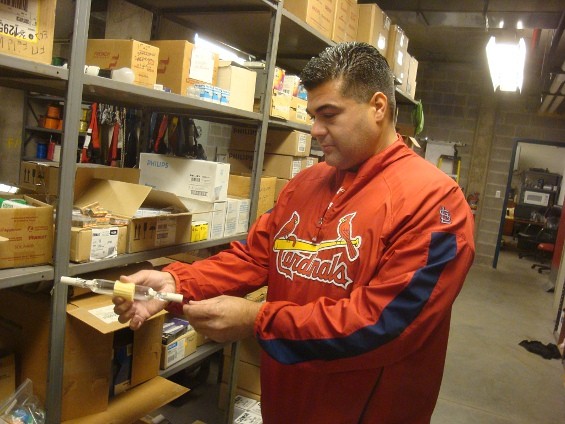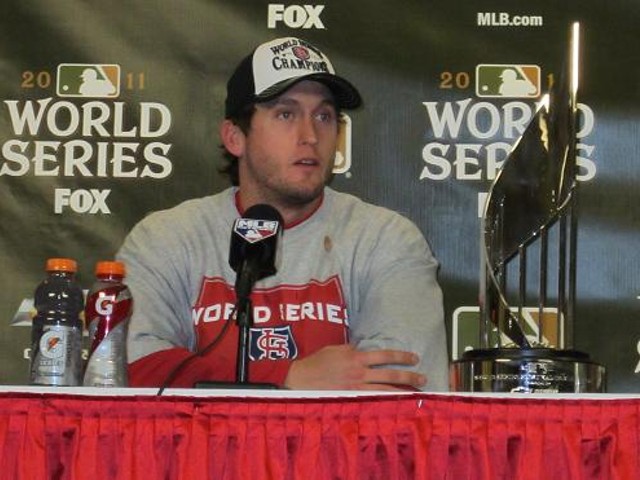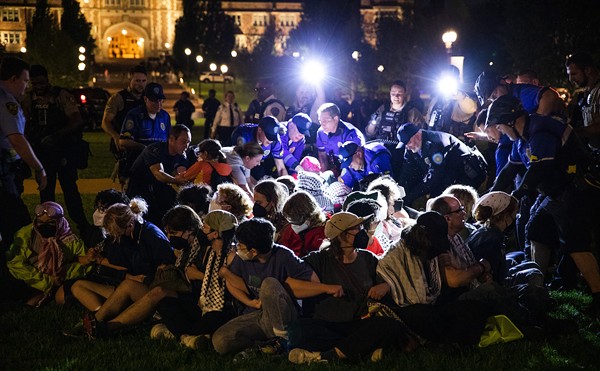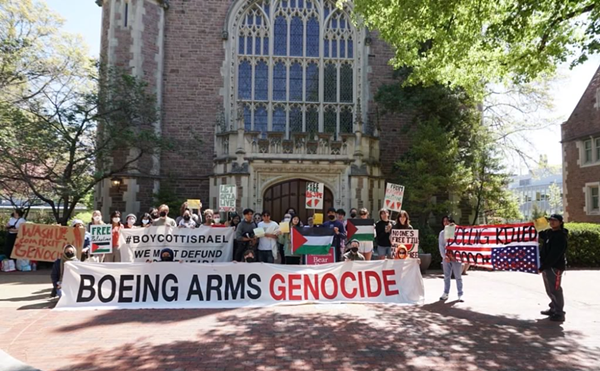Henry Bollinger woke up at 5:30 a.m. last Friday and tried not to disturb his wife and two young boys. He stepped out into the early-morning chill of Oakville, Missouri, and drove north, stopping only for a cup of coffee on his way to Busch Stadium. Once there, he took the elevator two flights down to a concrete corridor located behind the right-field bullpen. It smelled like fresh sawdust. He opened a set of rusty red metallic doors and stepped into a windowless bunker of an office where he controls the 660 light bulbs that last week illuminated history.
Bollinger's friends call him Hank. He grew up in south St. Louis, the son of a hospital administrator and lab technician. He remembers watching Cardinals infielder Tommy Herr hit his 10th inning walk-off grand slam against the Mets in 1987 at the old Busch Stadium, prompting Bollinger and other jubilant fans to shower the field with giveaway seat cushions. After high school Bollinger took a few electrical engineering courses at Forest Park Community College, then he joined the union. Now 40, he says he's lucky to be the Cardinal's head electrician. "It's a dream job," he says, standing on the warning track at 8:30 a.m., gazing up at his 660 lights.
On a clear night, westbound travelers on Interstate 70 can espy two flickering embers at the base of the Gateway Arch as they drive over the train tracks in East St. Louis. As the travellers draw nearer to the river, three distinct beacons emerge, spilling golden beams onto a little brick ballpark and turning a black sky into a misty blue.
The architect Earl Santee called for the lights at the new Busch Stadium to be arranged along six vertical towers to give the field a more luminous shine. The towers hover 198 feet above street level, each equipped with 80 2,000-watt metal halide sport lights, twenty maintenance lights and ten emergency lights. Two weeks after the stadium's inaugural game in 2006, Albert Pujols, who worried he wasn't seeing the ball well enough at night, took batting practice with the emergency and maintenance bulbs turned on. Pujols said the extra lights helped his vision, and they've burned during night games ever since.
A poster inside Hank Bollinger's bunker celebrates the Local 1 International Brotherhood of Electrical Workers. After taking an apprenticeship after college, Bollinger landed a job with Sachs Electric Company. In 1999 he started working the microphones and video board for the Cardinals, who contract with Sachs. He was appointed union steward in 2004, and the following year he helped construct the new Busch Stadium. He says he makes an average salary based on union standards.
Bollinger replaces about 100 bulbs a year, each costing $350. He knows when a lamp needs replacing by scoping it through a welder's mask. Every other year, the Cardinals electricians test the strength of the lights by partitioning the field into a grid of 200 parcels; they position each lamp in a different direction so that every blade of grass gets its equal due. Bollinger's bulbs bathe each square foot of the field with 310 foot-candles of light -- well above the Major League Baseball standard of 250.
Baseball lights first came to St. Louis in 194o, when the Cardinals and St. Louis Browns split the $150,000 cost for 784 1,500-watt lamps to be installed at Sportsman's Park. The lamps were affixed to towers ranging from 120 to 140 feet tall, providing 174 candlepower of light per square foot. It was an era when nearly all the professional teams were experimenting with lights. The Great Depression had decimated ticket revenues, and owners saw night ball as a novelty. The experiment paid off, ushering thousands of new fans into the ranks.






